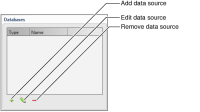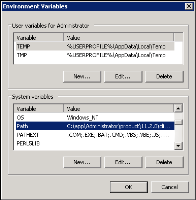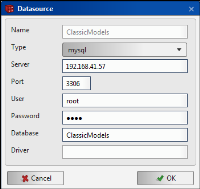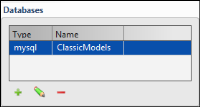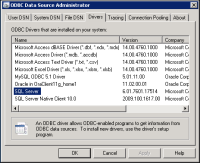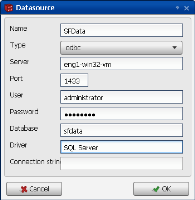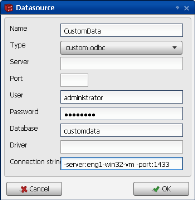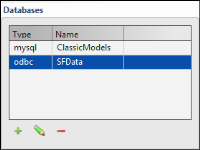Connecting to databases
You can create and name as many data source connections as a load process requires. The data sources can be of different types. For example, a load process can use data from a database and data from a flat file repository. Each type of data source requires different connection information.
BIRT Analytics Loader connects to databases using native and ODBC drivers. BIRT Loader supports native drivers for the following database types:

Microsoft SQL Server

MySQL Database Server

Oracle Database

PostgreSQL
BIRT Analytics Loader also supports connecting to a database using an ODBC driver. To connect to a database having a native driver type not supported by BIRT Analytics Loader, you must provide an ODBC driver and set up an ODBC connection that uses the ODBC diver.
In BIRT Analytics Loader you can define a new data source, edit an existing one, or remove a data source, as shown in
Figure 3‑2.
Figure 3‑2 Connection tools for database data sources
Using native drivers
Before creating a connection using a native driver make sure the driver is installed on your machine. For MySQL server for example, check if the path to the driver is in the System Path. To see the System Path, use Control Panel
➛System
➛Advanced System Settings
➛Environment Variables
➛Path, as shown in
Figure 3‑3.
Figure 3‑3 Editing Path variable
To create a data source connection you must provide the database connection information, as shown in
Table 3‑1. Contact your database administrator to obtain this information.
Table 3‑1 Database connection properties
Property | Description |
Name | The name of the database connection, which must be unique |
Type | The type of connection, selected from the values in the drop-down list |
Server | The database server, which can be a machine name or an IP address |
Port | The connection port |
User | A valid user name to connect to the database |
Password | A valid password to connect to the database |
Database | The name of the database |
Driver | The driver name, required for ODBC drivers only |
Connection string | Custom connection properties, required for custom ODBC drivers only |
How to connect to a database using a native driver
1 In Databases, choose the + sign. Datasource appears, as shown in
Figure 3‑4.
Figure 3‑4 Using a native driver
2 In Datasource, define the following properties:

In Name, type a unique name. Using a name that describes the database content helps identify different databases you define as data sources.

In Type, select the source database type from the list of available types. In this example, mysql is the source database type.

In Server, type the name of the server that hosts the source database. In this example, an IP address identifies that server.

In Port, type the connection port. The mysql database installation in this example uses the default port 3306.

In User, type a valid user name defined for the source database.

In Password, type a valid password defined for the source database.

In Database, type the name of a database that contains source data.

In Driver, optionally type a native driver name, or type no characters. A connection that uses a native driver requires no name.
3 Choose OK to create the named data source connection. A new data source connection name and type appear in Databases, as shown in
Figure 3‑5.
Figure 3‑5 A data source connection that uses a native database driver
Using ODBC drivers
Creating a connection using an ODBC driver is very similar to the native driver connections. The difference is that you must provide a driver name as a connection property. As well as the predefined ODBC data source types, a custom ODBC data source is available. To use the custom ODBC data source, you must type the required connection parameters as a text value.
To determine the name of your ODBC driver, open Control Panel
➛ODBC Data Source Administrator. The driver name appears in the Drivers tab, as shown in
Figure 3‑6.
Figure 3‑6 Finding an ODBC driver name
How to connect to a database using an ODBC driver
1 In Databases, choose the + sign. Datasource appears.
In Datasource, define the following properties for a standard ODBC data source, as shown in
Figure 3‑7:
Figure 3‑7 Using an ODBC driver

In Name, type a unique name. Using a name that describes the database content helps identify different databases you define as data sources.

In Type, select ODBC from the list of available connection types.

In Server, type the name of the server that hosts the source database. In this example, a machine name, eng1-win32-vm, identifies that server.

In Port, type the connection port. The mssql database installation in this example uses the default port, 1433.

In User, type a valid user name defined for the source database.

In Password, type a valid password defined for the source database.

In Database, type the name of a database that contains source data.

In Driver, type the driver name, as defined in the ODBC Data Source Administrator. In this example, the name of the ODBC Microsoft SQL Server driver is SQL Server.
Alternatively, for a custom ODBC data source, define the following properties, as shown in
Figure 3‑8:
Figure 3‑8 Using a custom ODBC driver

In Name, type a unique name. Using a name that describes the database content helps identify different databases you define as data sources.

In Type, select Custom ODBC from the list of available connection types.

In User, type a valid user name defined for the source database.

In Password, type a valid password defined for the source database.

In Database, type the name of a database that contains source data.

In Connection string, type the parameters required to connect to the custom data source.
2 Choose OK to create the named data source connection. A new data source connection name and type appear in Databases, as shown in
Figure 3‑9.
Figure 3‑9 Database connections
